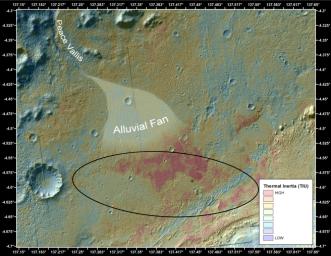This false-color map shows the area within Gale Crater on Mars, where NASA's Curiosity rover landed on Aug. 5, 2012 PDT (Aug. 6, 2012 EDT). It merges topographic data with thermal inertia data that record the ability of the surface to hold onto heat. Red indicates a surface material that retains its heat longer into the evening, suggesting differences relative to its surroundings. One possibility is that the materials that make up these soils and rocks have been more tightly bound together by mineral cements. The black oval indicates the targeted landing area for the rover, known as the "landing ellipse," and the cross shows where the rover actually touched down at the Bradbury Landing site.
An alluvial fan, or fan-shaped deposit where debris spread out downslope, has been highlighted in lighter colors for better viewing. On Earth, alluvial fans often are formed by water flowing downslope. New observations from Curiosity of rounded pebbles embedded with rocky outcrops provide concrete evidence that water did flow in this region on Mars, creating the alluvial fan. Water carrying the pebbly material is thought to have streamed downslope, extending the alluvial fan, at least occasionally, to where the rover now sits, studying its ancient history. The evidence for former water at the Bradbury Landing site may help the science team better understand the nature of the red areas in this map.
The rover is heading toward Glenelg, just to the lower right of Bradbury, where three different types of material connect up in a "triple junction."
This image was obtained by the Thermal Emission Imaging System on NASA's Odyssey orbiter.
JPL manages the Mars Science Laboratory/Curiosity for NASA's Science Mission Directorate in Washington. The rover was designed, developed and assembled at JPL, a division of the California Institute of Technology in Pasadena.
For more about NASA's Curiosity mission, visit: http://www.jpl.nasa.gov/msl, http://www.nasa.gov/mars, and http://marsprogram.jpl.nasa.gov/msl.

 Planetary Data System
Planetary Data System












